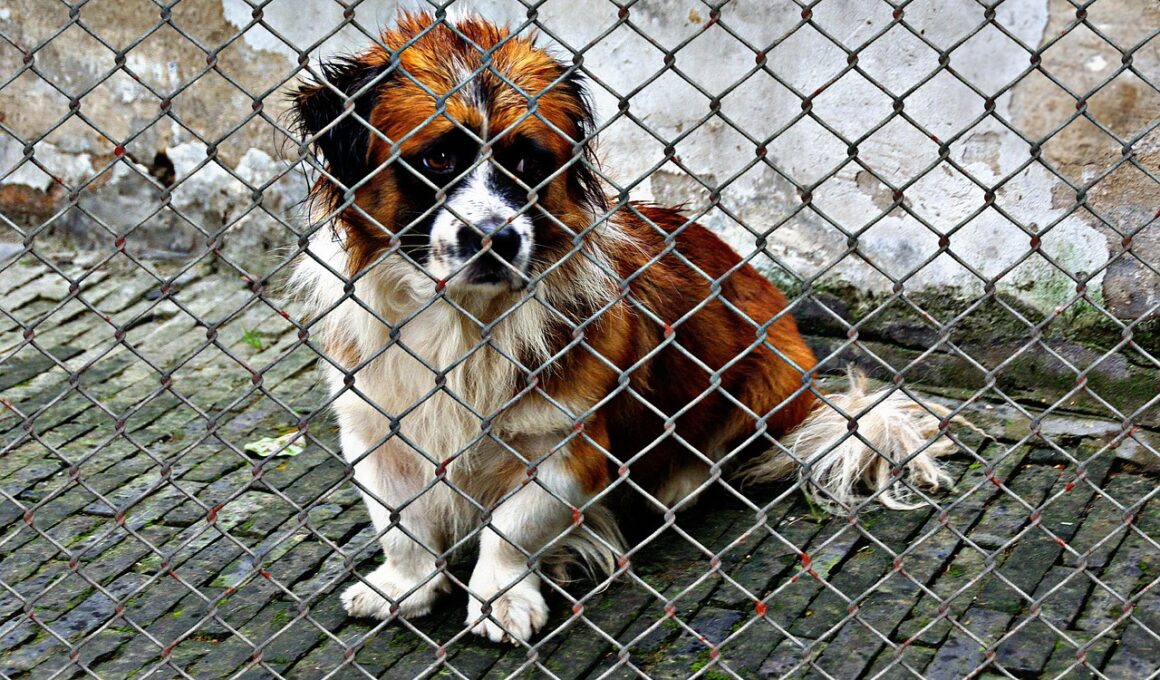First Aid Tips for Transporting Rescued Dogs
Transporting rescued dogs is a critical process that requires consideration and planning. When taking rescued dogs to their new foster or forever homes, it is essential to ensure their safety and comfort. Proper preparations significantly influence the experience of both the dogs and their rescuers. Remember that each dog may react differently to travel, especially if they have a traumatic background. A calm approach can make the transition smoother. Before transporting, gather all necessary supplies. This includes a secure crate that allows dogs to stand, turn around, and lie down comfortably. Additionally, ensure the crate has adequate ventilation. Always have fresh water available and consider familiar items for comfort. Furthermore, pay attention to the weather conditions—extreme temperatures can stress the dog. Regular stops during the journey are vital so that the dog can relieve itself if needed. If the dog shows signs of anxiety or stress, remove distractions while reassuring them with soothing words. Planning is vital to overall success and the well-being of transported dogs. Always prioritize the animal’s comfort, health, and emotional state throughout the process.
Before starting the transport, ensure that all necessary vaccinations and health checks are up to date. This is crucial in avoiding the spread of diseases among other animals. Carry a copy of the dog’s health records with you to present at checkpoints or to new owners. Always have a basic first-aid kit on hand, containing essentials such as antiseptic, bandages, tweezers, and gloves. This kit will enable swift response to any injuries or health issues that may arise during transport. In the case of an accident or emergency, being prepared can make a substantial difference. When assigning a driver for the transport, ensure that someone is familiar with the basic handling of dogs. Also, consider the route—avoid heavily trafficked roads if possible to minimize stress. If a dog needs to be walked during stopovers, ensure they are on a secure leash and harness, preventing any escape. Remember that patience is key; dogs can pick up on human emotions. Keep calm, speak softly, and show empathy. The transport process can be overwhelming, both for people and dogs. Positive handling greatly influences the dog’s mood and behavior.
Understanding Signs of Stress in Dogs
Understanding stress signals is vital during transport. Dogs can exhibit various behaviors indicating anxiety, such as whining, barking, excessive panting, or attempts to hide. Recognizing these signs early can help you mitigate stress and provide necessary support. If a dog seems agitated, stop and give them time to let off steam. Use calming techniques, such as soft voices, gentle petting, and minimizing loud noises. For dogs that react strongly to travel, consider using soft music to create a soothing environment. Additionally, familiar items such as blankets or toys can provide a sense of security. Create a plan for every stop during the journey, considering the dog’s needs for bathroom breaks and exercise. Healthy snacks can also help to distract them and ease anxiety. Moreover, allow the dog some time to explore their new environment upon arrival. Gradual introductions can reduce fear and promote a sense of belonging. Always express love and encouragement to reassure them. The more comfortable the dogs feel, the more well-adjusted they will become over time. Patience, understanding, and a little moral support can transform their travel experience significantly.
Another essential aspect of transporting rescued dogs is ensuring proper hydration throughout the journey. Keeping the dogs hydrated helps prevent health issues related to stress and fatigue. Consider offering water during rest stops, especially after long durations of travel. Proper hydration can minimize anxiety levels, promoting a calmer travel experience. If a dog seems hesitant to drink, try using a portable water bowl or offering ice cubes, which can be more appealing. Monitor how often dogs are drinking during transit; dehydration can quickly become serious. Always evaluate their physical condition as signs of dehydration can include dry gums, lethargy, or excessive panting. When possible, schedule transport during cooler parts of the day, avoiding peak sun hours to keep the environment comfortable. Careful attention to both hydration and temperature leads to a smoother journey. Another useful tip is to line the transport area with absorbent materials; this will help manage any accidents and maintain cleanliness. Preparing properly for hygiene issues not only benefits the dogs but also helps keep the vehicle comfortable. This preparedness is highly beneficial in easing the recovery process for rescued dogs.
Creating a Safe Environment
Ensuring a safe environment during transport is crucial in reducing the potential for injuries. Always secure crates in the vehicle to prevent them from moving during transit. Properly securing crates will protect the dogs during sudden stops or swerves and reduce the risk of accidents. Utilize safety belts to anchor the crates firmly in place. Avoid allowing dogs to roam freely in the vehicle, which can lead to distractions and accidents for the driver. Additionally, consider using a non-slip surface in areas where dogs will be transported, creating better stability. It’s also wise to use safety barriers if possible to prevent dogs from entering the front seat. Choose a vehicle that is spacious enough to accommodate the number of dogs being transported comfortably. Regularly inspect the vehicle for any potential hazards, such as open windows or sharp edges, to avoid injury. When planning longer trips, ensure there are adequate stops for dogs to stretch and relieve themselves safely. Peaceful vehicle dynamics during travel can significantly influence a dog’s travel experience and emotional stability.
In cases of transporting dogs with special needs, extra precautions are paramount for their safety and comfort. Many dogs may require additional support or medications during a journey, depending on their health conditions. Always ensure any medications they might need are packed and ready. Prioritize comfort by using soft blankets or cushions in their crates. If transportation takes longer, consider taking breaks more frequently to check on their condition. Dogs requiring more attention might need checking every hour or so to ensure they remain stable during travel. Reminder of the dog’s behavior throughout the journey will pave the way for future transport experiences. If the dog exhibits unusual or concerning behavior, promptly address it to prevent stress escalation. Communication with driving personnel is essential to understand the dog’s specific needs and maintain a united approach. This partnership can make all the difference in ensuring safety and providing nurturing care to these loving animals. Stress can be significantly alleviated through proper measures tailored specifically to their needs, enhancing overall well-being throughout the transportation process.
Follow-Up Care After Transport
After transporting rescued dogs, follow-up care becomes crucial for their transition. Upon arrival, assess each dog’s condition and emotional state. This evaluation can inform the next steps in their recovery and integration into a new environment. Providing fresh water and a small meal after the journey can help them regain energy. Conduct a thorough health check for any signs of stress or physical issues sustained during travel. If there is any concern, it is wise to schedule an immediate visit with a veterinarian. Additionally, creating a welcoming and calm introduction to their new surroundings is vital to reduce anxiety levels. Set up a cozy space where they can rest and feel secure. Gradually introduce them to new family members and other pets to prevent overwhelming them. It may take time for a dog to acclimate fully, so provide ample love and patience. Monitor their progress over the following days to ensure proper adaptation. Through attentive care and a calm approach, rescued dogs can flourish in their new homes, gaining trust and affection with time.
Finally, fostering a connection with a vet or local rescue organization can be beneficial for additional resources and support. Resources often include training, behavioral consultations, and continual care for rescued dogs. Engaging with the rescue community allows for shared experiences and advice, creating a broader support network. For those involved in the rescue process, staying well-informed about first aid techniques specific to dog transport is essential for being prepared. It’s recommended to consider enrolling in a canine first aid certification course, which equips rescuers with the necessary skills and knowledge. Moreover, sharing experiences can inspire others and potentially lead to new ideas and methods in facilitating safe dog transport. Regular updates on the dogs can also provide insights into their growth, reassuring everyone involved in their rescue journey. Offer guidance to new volunteers about best practices and what works best. Emphasizing the importance of education and community engagement ultimately leads to successful and safe dog transportation processes. In unity, everyone plays a vital role in ensuring the welfare of each special dog, which should always be the priority.


